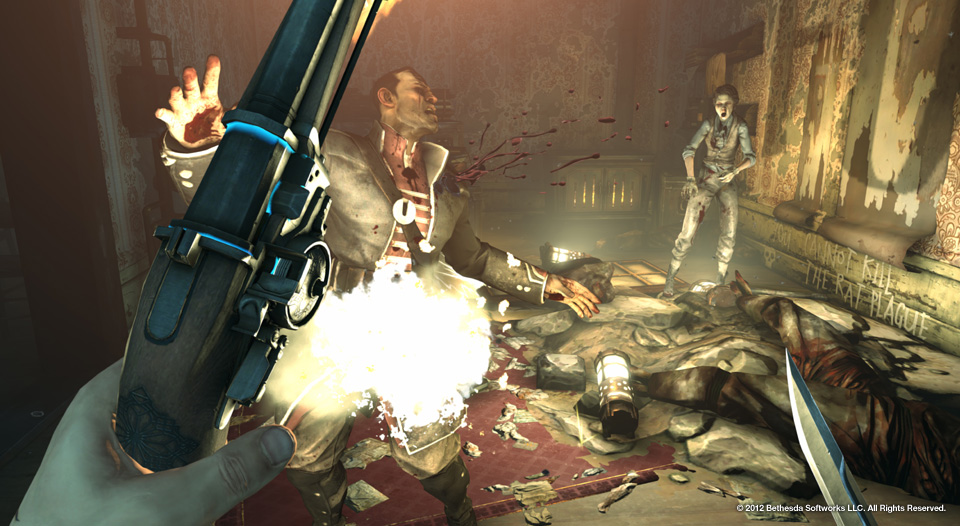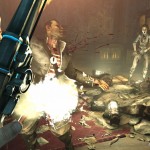 Level design. It’s one of the hardest parts of a game to get right, and yet it’s one of the hardest things to appraise or write about as a reviewer. Like an evocative movie soundtrack or natural dialogue in a book, it’s one of those things that we notice more when it is wrong than when it is right. In the case of Dishonored though, level design is so good that you can’t help but notice it. There are moments where you have to take a break, sit back and admit, “Yes Mr Designer, that was well done.”
Level design. It’s one of the hardest parts of a game to get right, and yet it’s one of the hardest things to appraise or write about as a reviewer. Like an evocative movie soundtrack or natural dialogue in a book, it’s one of those things that we notice more when it is wrong than when it is right. In the case of Dishonored though, level design is so good that you can’t help but notice it. There are moments where you have to take a break, sit back and admit, “Yes Mr Designer, that was well done.”
It takes a while to realise how great Dishonored’s level design is though. First impressions are mixed and initially Dishonored is not a great looking game. Muddy textures and a muted colour palette make the whole thing look a bit washed out and dull. Faces are heavily stylised in a way somewhat similar to Team Fortress, but this design often fails to work and simply results in very weird or ugly looking NPC’s. At first glance environments are conceptually clever and the steam punk setting is excitingly novel, but the world itself can look low on detail. It’s only with exploration and utilisation of your powers that you come to see how complex and interconnected the areas of the game world are and how many secret paths and areas are hidden throughout the areas you explore. Once you escape the starting areas you will come to realise that every time you need to sneak into a building you will have more options for secret routes than you could ever find in one playthrough.
 It also takes a long time to figure out exactly what kind of game Dishonored is. In many ways, the game itself feels like it’s the result of throwing ten different titles into a blender and making a smooth, creamy paste of new gameplay where you chew on the occasional lump of something that tastes familiar. Early on the visual aesthetic and relatively linear nature of the game – wherein you evade the troops of a totalitarian police state – make it feel like you are back in Half Life 2’s City 17. Later, the combination of weapons and supernatural powers wielded in both hands make you feel like you are back in Bioshock’s Rapture. Later again there are nods to the Thief games stealth approach as you sneak through houses filled with secret passages, antiques to steal, guards to dispatch and bodies to hide in dark corners. It’s Deus Ex that it most closely resembles though, particularly the first one. Not since that seminal, choice laden FPS has there been a game that offers so many options to the player in how they complete tasks.
It also takes a long time to figure out exactly what kind of game Dishonored is. In many ways, the game itself feels like it’s the result of throwing ten different titles into a blender and making a smooth, creamy paste of new gameplay where you chew on the occasional lump of something that tastes familiar. Early on the visual aesthetic and relatively linear nature of the game – wherein you evade the troops of a totalitarian police state – make it feel like you are back in Half Life 2’s City 17. Later, the combination of weapons and supernatural powers wielded in both hands make you feel like you are back in Bioshock’s Rapture. Later again there are nods to the Thief games stealth approach as you sneak through houses filled with secret passages, antiques to steal, guards to dispatch and bodies to hide in dark corners. It’s Deus Ex that it most closely resembles though, particularly the first one. Not since that seminal, choice laden FPS has there been a game that offers so many options to the player in how they complete tasks.
The story set up is simple, and while it frames the action well – breaking each mission of the game into a series of targets that need to be disposed of – the narrative is both predictable and uninspired. I say disposed of rather than assassinated as the game gives you many choices, including how you dispose of the high ranking targets you need to eliminate. While killing them is an option, you can often engineer fates that spare there life, but seem much crueller than death. Despite the clever way that plot points are resolved in these cases, the story never really grabs your attention. Taking a back seat to Dishonored’s involving gameplay, you play as a bodyguard to the Empress turned assassin, and predictably when she is killed you are framed for her murder.
 As well as having a predictable plot the main cast of characters have to deliver some seriously clunky dialogue. The credits show an impressive range of Hollywood stars, but they are poorly used. Combined with an unexceptional and generic soundtrack, the disappointing dialogue breaks immersion in an otherwise convincing world full of brilliant ambient sound effects. The overheard conversations from guards are full of dark humour and combine with little environmental details like graffiti and posters on walls to tell a better story than the star-laden cut scenes can manage. One of the best things about Half Life 2 was that it told the background story of the world through little incidental details and overheard snippets of conversations and this is just another great idea that Dishonored appropriates from Valve’s classic title.
As well as having a predictable plot the main cast of characters have to deliver some seriously clunky dialogue. The credits show an impressive range of Hollywood stars, but they are poorly used. Combined with an unexceptional and generic soundtrack, the disappointing dialogue breaks immersion in an otherwise convincing world full of brilliant ambient sound effects. The overheard conversations from guards are full of dark humour and combine with little environmental details like graffiti and posters on walls to tell a better story than the star-laden cut scenes can manage. One of the best things about Half Life 2 was that it told the background story of the world through little incidental details and overheard snippets of conversations and this is just another great idea that Dishonored appropriates from Valve’s classic title.
So if you have a great, atmospheric world to explore, what do you actually do in that world? Well for the most part, you either sneak around or fight. A lot. At every point in Dishnored you have multiple choices about how to tackle any problem or obstacle that you face. You can always choose to simply fight your way past, so lets deal with that first.
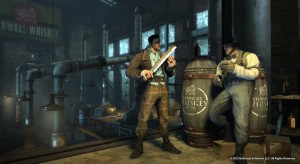 Played out in first person, combat is quick and brutal and based on timing and creative use of your abilities. It’s reminiscent of the slightly obscure Dark Messiah of Might and Magic, whereby you can be as effective by using the myriad powers at your disposal as slashing with your sword. Often it’s easier to use a whirlwind to blow an enemy off a high platform to their doom than to engage them in a sword fight. Unlocked as you progress through runes you collect, these powers give you a ridiculous number of options in every fight. While engaging enemies with your ever-present sword allows you to parry and counter attack, producing vicious and enjoyable execution animations, it’s the variety of other powers and gadgets you can use in combat that really excite. You can shoot enemies with your pistol, and this black powder weapon is brilliantly loud and deadly, blowing enemies away with easy. You can freeze time and massacre enemies as they stand mutely in place, unable to move. You can lay down explosive wire traps that eviscerate opponents and chop them into pieces. You can toss bombs (complete with comedy burning fuse) and blow your enemies to pieces. In fact, many of the more powerful weapons can dismember your enemies. It’s curious that the game features some of the most grisly corpse dismemberment seen in a game since Soldier of Fortune. At one point I cut an enemies head from its shoulder to see it fall from the high bridge we were on and plop dramatically into the sea below. It was shockingly brilliant and scarily satisfying.
Played out in first person, combat is quick and brutal and based on timing and creative use of your abilities. It’s reminiscent of the slightly obscure Dark Messiah of Might and Magic, whereby you can be as effective by using the myriad powers at your disposal as slashing with your sword. Often it’s easier to use a whirlwind to blow an enemy off a high platform to their doom than to engage them in a sword fight. Unlocked as you progress through runes you collect, these powers give you a ridiculous number of options in every fight. While engaging enemies with your ever-present sword allows you to parry and counter attack, producing vicious and enjoyable execution animations, it’s the variety of other powers and gadgets you can use in combat that really excite. You can shoot enemies with your pistol, and this black powder weapon is brilliantly loud and deadly, blowing enemies away with easy. You can freeze time and massacre enemies as they stand mutely in place, unable to move. You can lay down explosive wire traps that eviscerate opponents and chop them into pieces. You can toss bombs (complete with comedy burning fuse) and blow your enemies to pieces. In fact, many of the more powerful weapons can dismember your enemies. It’s curious that the game features some of the most grisly corpse dismemberment seen in a game since Soldier of Fortune. At one point I cut an enemies head from its shoulder to see it fall from the high bridge we were on and plop dramatically into the sea below. It was shockingly brilliant and scarily satisfying.
If you choose to go down a pure combat route you will find enemies get more challenging the more you fight. Ammunition is scarce if you try to kill everyone and enemies will pull out guns or toss grenades at your feet. When facing multiple opponents you get the feeling that while the sword aspects of the combat might be a bit basic, they are also not designed to allow you to face many enemies at once. You’re not Ezio, so while you can effectively parry and counter one enemy, you have no ability to chain together multiple kills and must rely on the powers at your disposal. Chugging health potions will get you through some encounters, but as enemies start wearing armoured masks and come with attack dogs, even the most aggressive player will begin to realise the benefits of stealth killing some of the enemies rather than always engaging on a full on frontal assault.
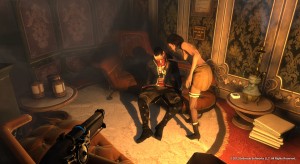 Despite the depth of the combat system you always feel that Dishonored is pushing you to try to be stealthy. You can skulk around in a kind of crouch, and if you play like me you will probably move through most of the game like this. Crouching in the shadows, you will use your powers to help you get past guards without being caught. An early ability that lets you see enemies through walls is essential if you want to avoid turning a corner and bumping into one.
Despite the depth of the combat system you always feel that Dishonored is pushing you to try to be stealthy. You can skulk around in a kind of crouch, and if you play like me you will probably move through most of the game like this. Crouching in the shadows, you will use your powers to help you get past guards without being caught. An early ability that lets you see enemies through walls is essential if you want to avoid turning a corner and bumping into one.
Guards have little alert meters, and these will fill up very fast if they spot you in the open. You can lean out from cover to peak around corners or over obstacles without risk of being caught, but the ability to look through walls quickly makes this obsolete. One initial power you are granted at the start of the game that is useful until the very end is blink. Used to traverse the world, it effectively allows you to teleport short distances and thus, hop from cover to cover without being seen. It also allows you to reach high ledges and rooftops, and a great deal of time is spent in Dishonored sneaking around above enemies. The way you climb platforms and ledges is much better than most FPS’s, and there’s rarely a time when you feel like you can’t climb up to something that you could in real life. Getting above enemies to get the drop on them is great, mischievous fun, and you always feel like you are subtly cheating the game despite these secret high routes being laid out by the games designers.
 Indeed the thrill of “cheating” your way through Dishonored is the best thing about it. You have such a huge toolbox of tricks that every new challenge is exciting as you try to use a combination of your powers to get in and out of an environment in the sneakiest way possible. The game is at its very best when you encounter a new area for the first time and piece together exactly how you will sneak into a secure building, eliminate a target and get away without anyone knowing you had been there. This is where the games amazing level design comes in. If you think of some sneaky way to infiltrate an enemy base then chances are the developers will have set up a secret path for you to use. Whether you want to use your blink power to climb a building and enter an upstairs window, possess a rat and climb in through the basement via the sewers or simply wait till the guards are all facing the wrong way, freeze time and walk in the front door, the game encourages you to try. It’s often only after you complete a mission you realise how many other options you had that you could have tried. As a result, even when you have just finished a mission you feel like trying it all over again a different, sneakier way. We can only hope the upcoming Hitman Absolution handles assassinations as well as this.
Indeed the thrill of “cheating” your way through Dishonored is the best thing about it. You have such a huge toolbox of tricks that every new challenge is exciting as you try to use a combination of your powers to get in and out of an environment in the sneakiest way possible. The game is at its very best when you encounter a new area for the first time and piece together exactly how you will sneak into a secure building, eliminate a target and get away without anyone knowing you had been there. This is where the games amazing level design comes in. If you think of some sneaky way to infiltrate an enemy base then chances are the developers will have set up a secret path for you to use. Whether you want to use your blink power to climb a building and enter an upstairs window, possess a rat and climb in through the basement via the sewers or simply wait till the guards are all facing the wrong way, freeze time and walk in the front door, the game encourages you to try. It’s often only after you complete a mission you realise how many other options you had that you could have tried. As a result, even when you have just finished a mission you feel like trying it all over again a different, sneakier way. We can only hope the upcoming Hitman Absolution handles assassinations as well as this.
And this is just the start. The game layers on more and more systems and powers that you can use and that interact with each other. You can choose whether to simply knock out guards or kill them outright. Either way you will be picking up the bodies and hiding them in dumpsters and dark corners. You will summon rat plagues that consume dead bodies. Sleep darts will knock out enemies silently. An airborne assassination will allow you to hit the ground without any noise. Killing enemies can build an adrenalin meter for more viscous attacks. The more you play the more you see opportunities to use your powers disruptively and it’s always gleeful, mischievous fun. In an early mission, poisoning someone’s drinking glass then knocking out his friend with a sleep dark before carrying them out a nearby window and teleporting to safety as the alarms were raised in the background left me grinning like an idiot at how perfectly my plan had come together.
 And the game actively pushes you towards these stealthy, crafty strategies. Every opportunity it has it tells you that if you kill too many people then the ending of the game will be “darker”. You are told that killing enemies will both raise the somewhat nebulously defined “chaos” throughout the campaign, and more worryingly will result in more swarms of plague infested rats taking over the city. In this way the game encourages you to try to avoid killing too many people as you progress. At the end of each level a ranking will show how successful you were measured against a variety of criteria, including collectibles found, times that you set off an alarm and whether you managed to successfully complete a level without killing anyone or without being detected. This was a cause of initial frustration for me as I attempted to clear the early levels without casualties. One time I was sure that I had done this, but was told I had killed three enemies. In the second level I decided I would kill where necessary but would avoid being detected. I was sure I had managed, but the score screen at the end said I had raised an alarm. I’m not sure if alarming dogs or zombies counts, and whether guards knocked unconscious then mistakenly dropped in water are counted as kills, but the game never really communicates these systems clearly enough to tell you if you are succeeding or failing in these areas.
And the game actively pushes you towards these stealthy, crafty strategies. Every opportunity it has it tells you that if you kill too many people then the ending of the game will be “darker”. You are told that killing enemies will both raise the somewhat nebulously defined “chaos” throughout the campaign, and more worryingly will result in more swarms of plague infested rats taking over the city. In this way the game encourages you to try to avoid killing too many people as you progress. At the end of each level a ranking will show how successful you were measured against a variety of criteria, including collectibles found, times that you set off an alarm and whether you managed to successfully complete a level without killing anyone or without being detected. This was a cause of initial frustration for me as I attempted to clear the early levels without casualties. One time I was sure that I had done this, but was told I had killed three enemies. In the second level I decided I would kill where necessary but would avoid being detected. I was sure I had managed, but the score screen at the end said I had raised an alarm. I’m not sure if alarming dogs or zombies counts, and whether guards knocked unconscious then mistakenly dropped in water are counted as kills, but the game never really communicates these systems clearly enough to tell you if you are succeeding or failing in these areas.
For all that’s good about Dishonored there’s a fair few rough edges. You can map four powers or weapons to the D-Pad, but there is a huge selection of powers available and many buttons on the pad itself are used for fairly useless actions. The circle interface you bring up to use powers is also finicky and an unsatisfying way to interact with your abilities. It’s not hard to see how they could have made this better. For example, they could have used the block button together with the face buttons to activate different powers. Other games have found far more elegant control solutions than Arkane Studios have used here.
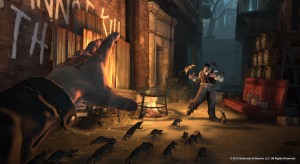 I also took a long time to get into a rhythm with the game. At first I wasn’t sure if I was supposed to kill enemies but not civilians, kill no one, or focus on avoiding detection. As a result, every time I thought I was detected I retried a section and got more and more frustrated as early on your relative lack of powers make it harder to go undetected. I also spent a huge amount of time exploring areas I didn’t need to beacuse I didn’t realise I would come back to them later in the story. It’s been reported that Dishonored can be completed in four hours, but I spent far longer than this in the first mission alone trying to eke out every secret when in fact I would have enjoyed the game far more engaging and the pacing better if I had simply followed the story more. Two pieces of advice I would give to you before you play:
I also took a long time to get into a rhythm with the game. At first I wasn’t sure if I was supposed to kill enemies but not civilians, kill no one, or focus on avoiding detection. As a result, every time I thought I was detected I retried a section and got more and more frustrated as early on your relative lack of powers make it harder to go undetected. I also spent a huge amount of time exploring areas I didn’t need to beacuse I didn’t realise I would come back to them later in the story. It’s been reported that Dishonored can be completed in four hours, but I spent far longer than this in the first mission alone trying to eke out every secret when in fact I would have enjoyed the game far more engaging and the pacing better if I had simply followed the story more. Two pieces of advice I would give to you before you play:
1. Don’t worry about killing or fighting the odd guard as it is fun and won’t cause you to get the dark ending unless you kill mountains of them.
2. Don’t explore every inch of the world on the first mission. You will find secret areas that won’t have collectibles in them till later.
If you follow these tips, you will probably come to love Dishonored as much as I did, and with much less frustration. It’s a game that’s littered with nice touches and great ideas, and while few of them are genuinely original, there’s the occasional moment of great design that stands out. A particular favourite of mine is the clockwork heart you can take out which both shows you where nearby collectibles are and also tells you secrets about anyone you point it at. Hearing that a little dialogue has been written for almost every NPC in the game is a lovely touch, and something that many gamers might never even experience. Indeed, Dishonored is defined by little moments that you find which others won’t. It’s of the Warren Spector school of game design, where the players experience is enriched by all the choices they take and the things they won’t see as much as the things they will. It’s a game where my story of how a mission played out will be far different to someone else’s, and games that allow you to tell your own story like this will always be more worthy than ones that simply take you on a roller-coaster ride through someone else’s story.
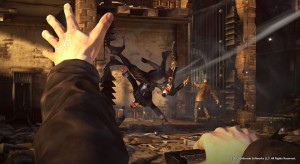 As a new game in a franchise Dishonored is a success, but it also has scope to improve in future instalments. Better combat, better communication with the player about goals and their mission status and better controls would all help. Also, the game engine is just a bit creaky, the world can be visually dull and the story is average. With an original and well told story to match the games excellent atmosphere and setting, tighter controls and a graphical overhaul, the next Dishonored could be a game of the year contender. For now though, it’s merely a very, very good game.
As a new game in a franchise Dishonored is a success, but it also has scope to improve in future instalments. Better combat, better communication with the player about goals and their mission status and better controls would all help. Also, the game engine is just a bit creaky, the world can be visually dull and the story is average. With an original and well told story to match the games excellent atmosphere and setting, tighter controls and a graphical overhaul, the next Dishonored could be a game of the year contender. For now though, it’s merely a very, very good game.
Running across rooftops with sword and crossbow in hand, jumping, teleporting and dispatching guards with silent, deadly efficiency, Dishonored is an encouraging step in the right direction for new IP’s. Open ended, engaging and an example of the very best in modern videogame level design, it’s the most exciting major new IP this year.
8 unconscious guards hidden in dumpsters out of 10
